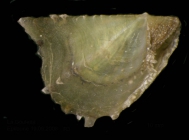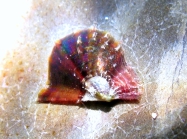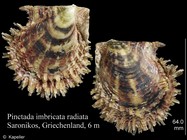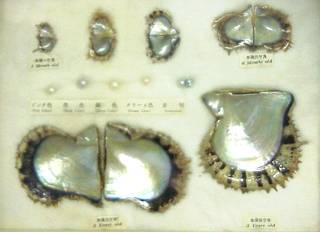MolluscaBase taxon details
Pinctada radiata (Leach, 1814)
140890 (urn:lsid:marinespecies.org:taxname:140890)
accepted
Species
Avicula radiata Leach, 1814 · unaccepted (original combination)
Avicula radiata Deshayes, 1830 · unaccepted > junior homonym (and synonym)
Meleagrina conemenosi Monterosato, 1884 · unaccepted > nomen nudum
Meleagrina occa (Reeve, 1857) sensu Pallary, 1912 · unaccepted > misapplication
Meleagrina radiata (Deshayes, 1830) · unaccepted > junior homonym (and synonym, with superseded...)
and synonym, with superseded combination)
Meleagrina savignyi Monterosato, 1884 · unaccepted
Pinctada imbricata radiata (Leach, 1814) · unaccepted
marine
(of Avicula radiata Leach, 1814) Leach, W. E. (1814-1817). Zoological miscellany: being descriptions of new or interesting animals. <em>London.</em> Vol. 1</i> [1814]. Vol. 2 [1815], Vol. 3 [1817]., available online at http://www.biodiversitylibrary.org/item/91180
page(s): 98; pl. 43 [details]
page(s): 98; pl. 43 [details]
Taxonomy The papers by Tëmkin (2010) and Cunha et al. (2011) were published about simultaneously and do not discuss each other's...
Taxonomy The papers by Tëmkin (2010) and Cunha et al. (2011) were published about simultaneously and do not discuss each other's results. Tëmkin treated fucata and radiata as geographical subspecies of imbricata, whereas Cunha et al. presented a molecular tree that resolved them at the rank of species. This may be a result of the two papers using different markers: Tëmkin used 18S, 28S, 16S, and H3, whereas Cunha et al. used 18S and CO1. The matter is not fully resolved. [details]
MolluscaBase eds. (2024). MolluscaBase. Pinctada radiata (Leach, 1814). Accessed at: https://www.molluscabase.org/aphia.php?p=taxdetails&id=140890 on 2024-04-19
Date
action
by
![]() The webpage text is licensed under a Creative Commons Attribution 4.0 License
The webpage text is licensed under a Creative Commons Attribution 4.0 License
original description
(of Meleagrina savignyi Monterosato, 1884) Monterosato, T. A. di. (1884). <i>Nomenclatura generica e specifica di alcune conchiglie mediterranee</i>. Virzi, printed for the author, Palermo, 152 pp. , available online at http://www.biodiversitylibrary.org/item/109711
page(s): 7 [details]
original description (of Avicula radiata Leach, 1814) Leach, W. E. (1814-1817). Zoological miscellany: being descriptions of new or interesting animals. <em>London.</em> Vol. 1</i> [1814]. Vol. 2 [1815], Vol. 3 [1817]., available online at http://www.biodiversitylibrary.org/item/91180
page(s): 98; pl. 43 [details]
original description (of Avicula radiata Deshayes, 1830) Deshayes, G. P. (1830-1832). <i>Encyclopédie méthodique ou par ordre de matières. Histoire naturelle des Vers et Mollusques</i>. Vol. 2: viii+1-594 [part 1: i-vi, 1-256, Livraison 101, 1 Feb 1830; part 2: 1-144, Livraison 101, 1 Feb. 1830; 145-594, Livraison 102, 29 Sept. 1832]. Vol. 3: 595-1152 [Livraison 102, 29 Sept. 1832]. , available online at https://doi.org/10.5962/bhl.title.8638
page(s): 102 [details]
context source (Introduced species) Streftaris, N., A. Zenetos & E. Papathanassiou. (2005). Globalisation in marine ecosystems: the story of non-indigenous marine species across European seas. <em>Oceanogry and Marine Biology: an Annual Review.</em> 43: 419-453. (look up in IMIS) [details] Available for editors [request]
[request]
basis of record Gofas, S.; Le Renard, J.; Bouchet, P. (2001). Mollusca. in: Costello, M.J. et al. (eds), European Register of Marine Species: a check-list of the marine species in Europe and a bibliography of guides to their identification. <em>Patrimoines Naturels.</em> 50: 180-213., available online at http://www.vliz.be/imisdocs/publications/ocrd/254404.pdf [details]
additional source Sheppard, A (1984). The molluscan fauna of Chagos (Indian Ocean) and an analysis ot its broad distribution patterns. Coral Reefs 3: 43-50. [details] Available for editors [request]
[request]
additional source Zenetos, A.; Çinar, M.E.; Pancucci-Papadopoulou, M.A.; Harmelin, J.-G.; Furnari, G.; Andaloro, F.; Bellou, N.; Streftaris, N.; Zibrowius, H. (2005). Annotated list of marine alien species in the Mediterranean with records of the worst invasive species. <em>Mediterranean Marine Science.</em> 6 (2): 63-118., available online at https://www.researchgate.net/publication/273213810_Annotated_list_of_marine_alien_species_in_the_Mediterranean_with_records_of_the_worst_invasive_species [details] Available for editors [request]
[request]
additional source Occhipinti-Ambrogi, A., A. Marchini, G. Cantone, A. Castelli, C. Chimenz, M. Cormaci, C. Froglia, G. Furnari, M.C. Gambi, G. Giaccone, A. Giangrande, C. Gravil, F. Mastrototaro, C. Mazziotti, L. Orsi-Relini & S. Piraino. (2010). Alien species along the Italian coasts: an overview. <em>Biological Invasions.</em> 13(1): 215-237., available online at https://doi.org/10.1007/s10530-010-9803-y [details] Available for editors [request]
[request]
additional source Zenetos, A.; Gofas, S.; Verlaque, M.; Cinar, M.; Garcia Raso, J.; Bianchi, C.; Morri, C.; Azzurro, E.; Bilecenoglu, M.; Froglia, C.; Siokou, I.; Violanti, D.; Sfriso, A.; San Martin, G.; Giangrande, A.; Katagan, T.; Ballesteros, E.; Ramos-Espla, A.; Mastrototaro, F.; Ocana, O.; Zingone, A.; Gambi, M.; Streftaris, N. (2010). Alien species in the Mediterranean Sea by 2010. A contribution to the application of European Union's Marine Strategy Framework Directive (MSFD). Part I. Spatial distribution. <em>Mediterranean Marine Science.</em> 11(2): 381-493., available online at https://doi.org/10.12681/mms.87 [details]
additional source Zamouri-Langar, N.; Chouba, L.; Ajjabi Chebil, L.; Mrabet, R.; El Abed, A. (2011). Les coquillages bivalves des côtes tunisiennes. Institut National des Sciences et Technologies de la Mer: Salammbô. ISBN 978-9938-9512-0-2. 128 pp. (look up in IMIS) [details]
additional source Cunha R.L., Blanc F., Bonhomme F. & Arnaud-Haond S. (2011) Evolutionary patterns in pearl oysters of the genus <i>Pinctada</i> (Bivalvia: Pteriidae). <i>Marine Biotechnology</i> 13: 181–192., available online at https://doi.org/10.1007/s10126-010-9278-y [details]
additional source Wronski, T. (2010). The molluscan bio-fouling community on the Red Sea pearl oyster beds. <em>Zoology in the Middle East.</em> 51(1): 67-73., available online at https://doi.org/10.1080/09397140.2010.10638442 [details] Available for editors [request]
[request]
additional source Almatar, S. M., Carpenter, K. E., Jackson, R., Alhazeem, S. H., Alsaffar, A. H., Ghaffar, A. R. A., & Carpenter, C. (1993). Observations on the pearl oyster fishery of Kuwait. <em>Journal of Shellfish research, 12(1).</em> 12(1): 35-40., available online at http://digitalcommons.odu.edu/cgi/viewcontent.cgi?article=1105&context=biology_fac_pubs [details] Available for editors [request]
[request]
additional source Scuderi, D.; Balistreri, P.; Germanà, A. (2019). Are <i>Pinctada radiata</i> (Leach, 1814) and <i>Pinctada fucata</i> (Gould, 1850) (Bivalvia Pteriidae) only synonyms or really different species? The case of some Mediterranean populations. <em>Biodiversity Journal.</em> 10(4): 415-426., available online at https://doi.org/10.31396/biodiv.jour.2019.10.4.415.426 [details]
page(s): 7 [details]
original description (of Avicula radiata Leach, 1814) Leach, W. E. (1814-1817). Zoological miscellany: being descriptions of new or interesting animals. <em>London.</em> Vol. 1</i> [1814]. Vol. 2 [1815], Vol. 3 [1817]., available online at http://www.biodiversitylibrary.org/item/91180
page(s): 98; pl. 43 [details]
original description (of Avicula radiata Deshayes, 1830) Deshayes, G. P. (1830-1832). <i>Encyclopédie méthodique ou par ordre de matières. Histoire naturelle des Vers et Mollusques</i>. Vol. 2: viii+1-594 [part 1: i-vi, 1-256, Livraison 101, 1 Feb 1830; part 2: 1-144, Livraison 101, 1 Feb. 1830; 145-594, Livraison 102, 29 Sept. 1832]. Vol. 3: 595-1152 [Livraison 102, 29 Sept. 1832]. , available online at https://doi.org/10.5962/bhl.title.8638
page(s): 102 [details]
context source (Introduced species) Streftaris, N., A. Zenetos & E. Papathanassiou. (2005). Globalisation in marine ecosystems: the story of non-indigenous marine species across European seas. <em>Oceanogry and Marine Biology: an Annual Review.</em> 43: 419-453. (look up in IMIS) [details] Available for editors
basis of record Gofas, S.; Le Renard, J.; Bouchet, P. (2001). Mollusca. in: Costello, M.J. et al. (eds), European Register of Marine Species: a check-list of the marine species in Europe and a bibliography of guides to their identification. <em>Patrimoines Naturels.</em> 50: 180-213., available online at http://www.vliz.be/imisdocs/publications/ocrd/254404.pdf [details]
additional source Sheppard, A (1984). The molluscan fauna of Chagos (Indian Ocean) and an analysis ot its broad distribution patterns. Coral Reefs 3: 43-50. [details] Available for editors
additional source Zenetos, A.; Çinar, M.E.; Pancucci-Papadopoulou, M.A.; Harmelin, J.-G.; Furnari, G.; Andaloro, F.; Bellou, N.; Streftaris, N.; Zibrowius, H. (2005). Annotated list of marine alien species in the Mediterranean with records of the worst invasive species. <em>Mediterranean Marine Science.</em> 6 (2): 63-118., available online at https://www.researchgate.net/publication/273213810_Annotated_list_of_marine_alien_species_in_the_Mediterranean_with_records_of_the_worst_invasive_species [details] Available for editors
additional source Occhipinti-Ambrogi, A., A. Marchini, G. Cantone, A. Castelli, C. Chimenz, M. Cormaci, C. Froglia, G. Furnari, M.C. Gambi, G. Giaccone, A. Giangrande, C. Gravil, F. Mastrototaro, C. Mazziotti, L. Orsi-Relini & S. Piraino. (2010). Alien species along the Italian coasts: an overview. <em>Biological Invasions.</em> 13(1): 215-237., available online at https://doi.org/10.1007/s10530-010-9803-y [details] Available for editors
additional source Zenetos, A.; Gofas, S.; Verlaque, M.; Cinar, M.; Garcia Raso, J.; Bianchi, C.; Morri, C.; Azzurro, E.; Bilecenoglu, M.; Froglia, C.; Siokou, I.; Violanti, D.; Sfriso, A.; San Martin, G.; Giangrande, A.; Katagan, T.; Ballesteros, E.; Ramos-Espla, A.; Mastrototaro, F.; Ocana, O.; Zingone, A.; Gambi, M.; Streftaris, N. (2010). Alien species in the Mediterranean Sea by 2010. A contribution to the application of European Union's Marine Strategy Framework Directive (MSFD). Part I. Spatial distribution. <em>Mediterranean Marine Science.</em> 11(2): 381-493., available online at https://doi.org/10.12681/mms.87 [details]
additional source Zamouri-Langar, N.; Chouba, L.; Ajjabi Chebil, L.; Mrabet, R.; El Abed, A. (2011). Les coquillages bivalves des côtes tunisiennes. Institut National des Sciences et Technologies de la Mer: Salammbô. ISBN 978-9938-9512-0-2. 128 pp. (look up in IMIS) [details]
additional source Cunha R.L., Blanc F., Bonhomme F. & Arnaud-Haond S. (2011) Evolutionary patterns in pearl oysters of the genus <i>Pinctada</i> (Bivalvia: Pteriidae). <i>Marine Biotechnology</i> 13: 181–192., available online at https://doi.org/10.1007/s10126-010-9278-y [details]
additional source Wronski, T. (2010). The molluscan bio-fouling community on the Red Sea pearl oyster beds. <em>Zoology in the Middle East.</em> 51(1): 67-73., available online at https://doi.org/10.1080/09397140.2010.10638442 [details] Available for editors
additional source Almatar, S. M., Carpenter, K. E., Jackson, R., Alhazeem, S. H., Alsaffar, A. H., Ghaffar, A. R. A., & Carpenter, C. (1993). Observations on the pearl oyster fishery of Kuwait. <em>Journal of Shellfish research, 12(1).</em> 12(1): 35-40., available online at http://digitalcommons.odu.edu/cgi/viewcontent.cgi?article=1105&context=biology_fac_pubs [details] Available for editors
additional source Scuderi, D.; Balistreri, P.; Germanà, A. (2019). Are <i>Pinctada radiata</i> (Leach, 1814) and <i>Pinctada fucata</i> (Gould, 1850) (Bivalvia Pteriidae) only synonyms or really different species? The case of some Mediterranean populations. <em>Biodiversity Journal.</em> 10(4): 415-426., available online at https://doi.org/10.31396/biodiv.jour.2019.10.4.415.426 [details]
 Present
Present  Inaccurate
Inaccurate  Introduced: alien
Introduced: alien  Containing type locality
Containing type locality
From editor or global species database
Taxonomy The papers by Tëmkin (2010) and Cunha et al. (2011) were published about simultaneously and do not discuss each other's results. Tëmkin treated fucata and radiata as geographical subspecies of imbricata, whereas Cunha et al. presented a molecular tree that resolved them at the rank of species. This may be a result of the two papers using different markers: Tëmkin used 18S, 28S, 16S, and H3, whereas Cunha et al. used 18S and CO1. The matter is not fully resolved. [details]From regional or thematic species database
Introduced species abundance in Tunisian part of the Mediterranean Sea - Eastern Basin (Marine Region) : Dominant [details]Introduced species abundance in Greek part of the Aegean Sea (Marine Region) : Rare [details]
Introduced species abundance in Egyptian part of the Mediterranean Sea - Eastern Basin (Marine Region) : Dominant [details]
Introduced species abundance in Tunisian part of the Mediterranean Sea - Eastern Basin (Marine Region) : Dominant [details]
Introduced species impact in Greek part of the Aegean Sea (Marine Region) : Other impact - undefined or uncertain [details]
Introduced species impact in Tunisia (Nation) : Other impact - undefined or uncertain [details]
Introduced species remark in Tunisian part of the Mediterranean Sea - Eastern Basin (Marine Region) : It became invasive by 1892 although it was not detected in a survey in 1882 [details]
Introduced species remark In Tunisian part of the Mediterranean Sea - Eastern Basin (Marine Region) : Currently is one of the most common molluscs on the whole Tunisian coast [details]
Introduced species vector dispersal in Tunisian part of the Mediterranean Sea - Eastern Basin (Marine Region) : Canals: natural range expansion through man-made canals [details]
Introduced species vector dispersal in Tunisian part of the Mediterranean Sea - Eastern Basin (Marine Region) : Invaded from tropical Indo-Pacific [details]
Introduced species vector dispersal in Greek part of the Aegean Sea (Marine Region) : Canals: natural range expansion through man-made canals [details]
Introduced species vector dispersal in Egyptian part of the Mediterranean Sea - Eastern Basin (Marine Region) : Canals: natural range expansion through man-made canals
Invaded from tropical Indo-Pacific [details]
Introduced species vector dispersal in Tunisian part of the Mediterranean Sea - Eastern Basin (Marine Region) : Canals: natural range expansion through man-made canals
Invaded from tropical Indo-Pacific [details]
Introduced species vector dispersal in English Channel (IHO Sea Area) : Debris: transport of species on human generated debris [details]
| Language | Name | |
|---|---|---|
| English | rayed pearl oyster | [details] |
| Modern Greek (1453-) | Μαργαριτοφόρο στρείδι | [details] |
To Barcode of Life (11 barcodes)
To Biodiversity Heritage Library (28 publications)
To Biodiversity Heritage Library (60 publications) (from synonym Avicula radiata Leach, 1814)
To European Nucleotide Archive (ENA)
To GenBank (68992 nucleotides; 19 proteins)
To Information system on Aquatic Non-Indigenous and Cryptogenic Species (AquaNIS) (from synonym Pinctada imbricata radiata (Leach, 1814))
To NMNH Extant Collection (IZ MOL 598200 Pearl)
To PESI
To PESI (from synonym Pinctada imbricata radiata (Leach, 1814))
To PESI (from synonym Avicula radiata Leach, 1814)
To USNM Invertebrate Zoology Mollusca Collection
To Biodiversity Heritage Library (28 publications)
To Biodiversity Heritage Library (60 publications) (from synonym Avicula radiata Leach, 1814)
To European Nucleotide Archive (ENA)
To GenBank (68992 nucleotides; 19 proteins)
To Information system on Aquatic Non-Indigenous and Cryptogenic Species (AquaNIS) (from synonym Pinctada imbricata radiata (Leach, 1814))
To NMNH Extant Collection (IZ MOL 598200 Pearl)
To PESI
To PESI (from synonym Pinctada imbricata radiata (Leach, 1814))
To PESI (from synonym Avicula radiata Leach, 1814)
To USNM Invertebrate Zoology Mollusca Collection
Website and databases developed and hosted by Flanders Marine Institute · Page generated on 2024-04-19 08:42:22+02:00 · Contact: Data Management Team





